Table of Contents
Introduction: Roof Types Explained
There are 5 major areas in every home:
1. Foundation
2. Plumbing
3. Roof
4. Electrical
5. HVAC
These 5 areas make up our Major-Items Inspection and are so important, they get all the attention at the end of every inspection.
And depending on the property, a Kansas City home can have one of many roof types:
In this blog post you will learn:
- Variations of for each roof type
- What the different roof types are made from
- Maintenance needs of the various roof types
- What to expect from each roof type
- How long the different roof types last
- Types of repairs for the different roof types
- Average cost of each roof type
This should help you better understand the types of roofs you’ll see as you shop for a home around Kansas City.
Asphalt Roof Types
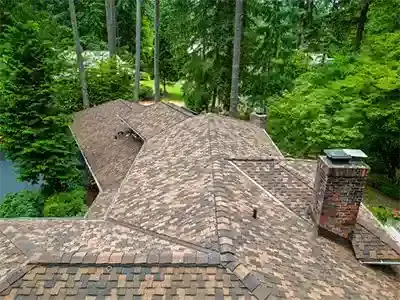
How many asphalt roof types are there?
There are 4 basic different types of asphalt shingle:
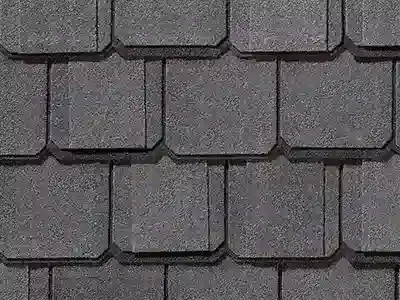
Luxury shingles
An upgraded shingle designed to look like cedar shingles or slate without the price or problems.
Expected lifespan:
25-40 years
Average cost: $275-$1,250 /square
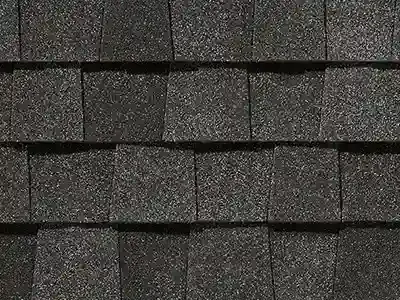
Premium shingles
Designed to resist high winds, solar rays, and hail impact. Many also offer algae and fire resistance.
Expected lifespan:
30-50 years
Average cost: $125-$965 /square
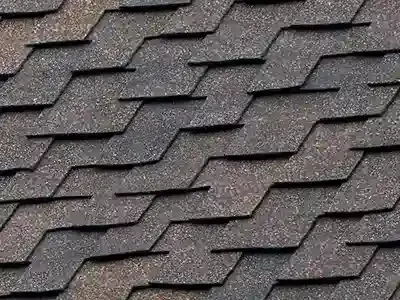
Architectural shingles
A step up from the flat 3-tab. Twice as thick, easier to install, and absorbs wind, rain, hail, and sun.
Expected lifespan: 20-25 years
Average cost: $98-$495 /square
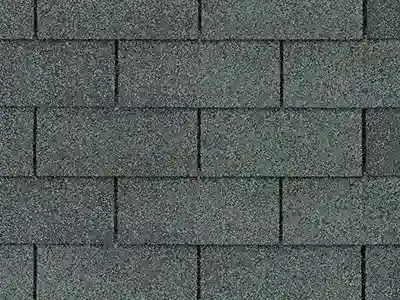
Traditional shingles
Also known as 3-tab or builder’s grade. It lays flat and offers the shortest lifespan and least protection.
Expected lifespan:
15-20 years
Average cost: $85-$315 /square
What are asphalt shingles made from?
Asphalt shingles are made up of a fiberglass mat, coated with asphalt then covered with mineral granules.
The asphalt provides waterproofing while the granules enhance durability and protect against rain, hail, and UV rays.
The various roof types use these materials in different thicknesses, styles, colors, and designs.
How long has asphalt been used for roof shingles?
Asphalt shingles were invented in 1903 by Henry Reynolds of Grand Rapids, MI.
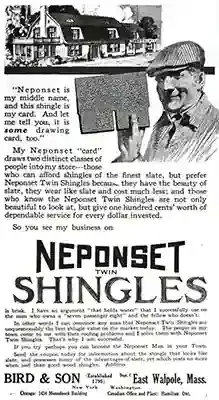
What can I expect from asphalt shingle roofs?
They’re durable, cost-effective, and come in various styles.
They provide good protection against the elements and can withstand different weather conditions.
With proper installation and maintenance, asphalt shingles can last for a couple of decades. They’re also relatively easy to replace if needed.
You can also expect moss and algae to grow on the North side of the roof since this side stays shaded from the sun and takes longer to dry.
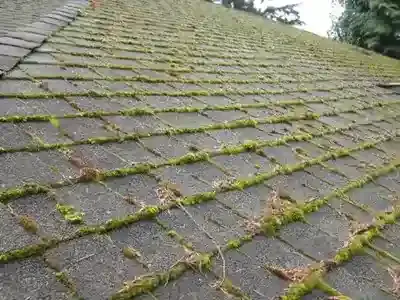
However, the South and West sides wear out faster than the North and East sides since these sides absorb the full impact of the wind, sun, hail, and rain.
What do master home inspectors say about maintaining asphalt shingles?
Consistent maintenance will stop small problems in their tracks while not only maximizing the life of your roof structure, but also the performance of your asphalt shingles:
- Regular Checks: Take a look at your roof from time to time, especially after severe weather. Check for any missing, damaged, or lifted shingles.
- Clean Gutters: Keep those gutters clean! Clogged gutters can lead to water backup and potential roof damage. Make sure water can flow freely.
- Moss and Algae Control: If you notice moss or algae growth, especially in shady areas, clean it off. These can damage shingles over time.
- Trim Overhanging Branches: Tree branches can cause shingle damage and give rodents a way to get into your home. Trim them back at least 6 feet from the edge of your roof.
- Proper Ventilation: Ensure your attic is well-ventilated. Proper ventilation helps regulate temperature and moisture, preventing premature aging of your shingles.
- Professional Inspection: Consider having professional home inspectors check your roof every few years to catch any issues early.
What are the 3 biggest issues with asphalt shingle roof types?
#1 Poor Ventilation
Poor ventilation can trap heat and moisture in the attic, leading to the premature deterioration of shingles and other roofing materials [3]. It can also cause condensation, which can further damage the roof structure.
#2 Moss / Algae Growth
Moss growth, while seemingly harmless, can cause significant problems for shingle roofs. It retains moisture and can cause the shingles to lift or curl, which can lead to leaks and other structural issues. Moss can also degrade the shingles over time, reducing the overall lifespan of the roof.
#3 Multiple Layers
Multiple layers of asphalt shingles add extra weight to the roof structure, which can lead to structural problems over time. Multiple layers can also trap heat, which can shorten the lifespan of the shingles.
Regular maintenance is crucial to prevent these issues and extend the lifespan of an asphalt shingle roof.
What does asphalt shingle deterioration and damage look like?

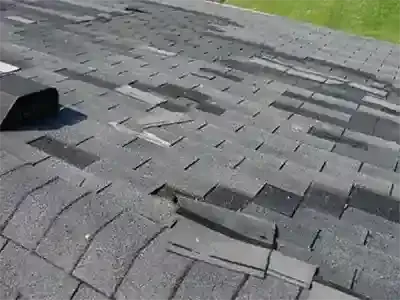
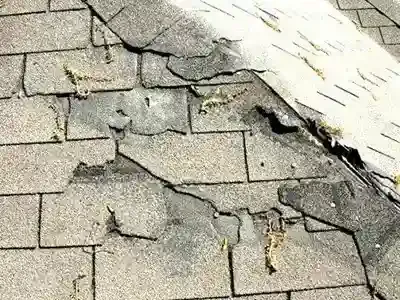

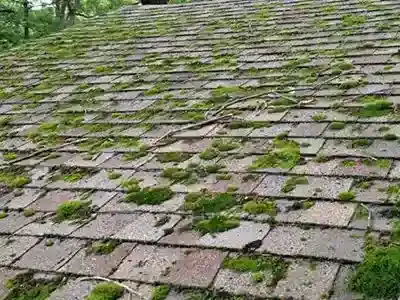

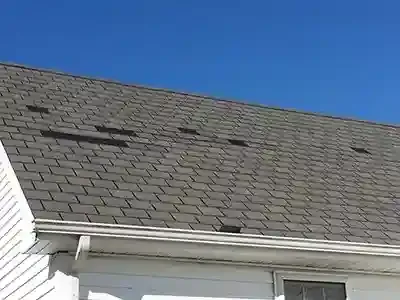
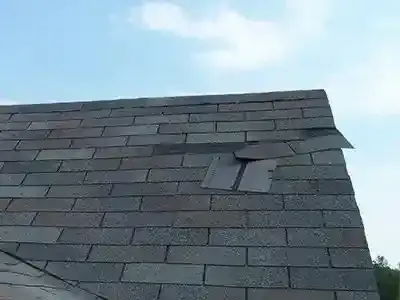
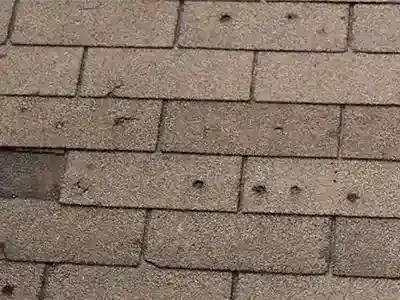
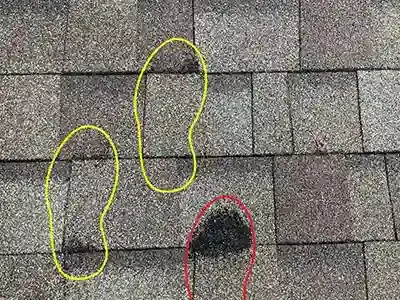
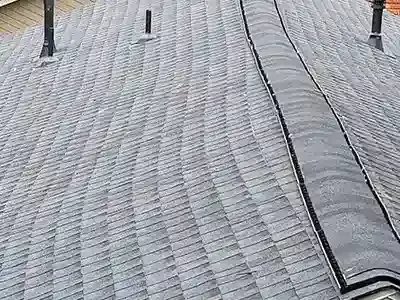



Average cost of asphalt shingle maintenance and repairs
| Type of Repair | Average Cost |
|---|---|
| Minor repairs | $150-$400 |
| Moderate repairs | $400-$1200 |
| Major repairs | $1200-$3500 |
Wood Roof Types

How many wood roof types are there?
There are 2 basic different types of wood shingle:

Cedar shake
Hand split with a textured and rustic look. They are also uneven and thicker than cedar shingles. A good choice for cabin and cottage-style homes.
Expected lifespan:
15-40 years
Average cost: $600-$1,100 /square
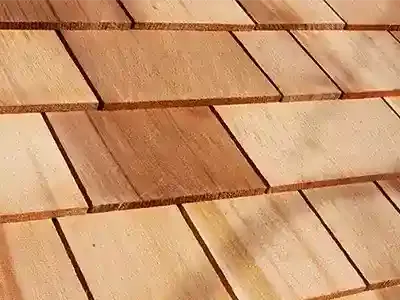
Cedar shingle
Machine cut and smoother than cedar shake. Cedar shingles are also lighter with a more consistent thickness. A good choice for contemporary homes.
Expected lifespan:
15-40 years
Average cost: $450-$850 /square
What are wood shingles made from?
Wood shake and cedar shingles are cut from trees grown in the Pacific NW and Canada. They’re first cut into 2-foot chunks before they become either hand-split or machine cut.
And because cedar shingles are made to order, they can take anywhere from 3 to 8 weeks to arrive.
What are the risks and hazards of using wood shingles?
Installing wood roof shingles are nice, but they also come with certain risks and downsides.
Here are the biggest issues homeowners face when installing cedar shingles on their roof:
Fire Hazard:
- Risk: Wood is inherently flammable, posing a higher fire risk compared to some other roofing materials.
- Mitigation: Applying fire retardant treatments and ensuring compliance with local building codes can help reduce this risk.
Rot and Decay:
- Risk: Wood is susceptible to rot and decay over time, especially in humid or wet climates.
- Mitigation: Proper ventilation, regular inspections, and treatment with wood preservatives can help prevent rot and decay.
Mold and Mildew:
- Risk: Moisture can lead to the growth of mold and mildew on wood shingles.
- Mitigation: Adequate ventilation, proper installation with sufficient space between shingles, and periodic cleaning can help prevent mold and mildew issues.
Insect Infestation:
- Risk: Wood is susceptible to insect infestations, such as termites or carpenter ants.
- Mitigation: Treating wood with insect repellents, regular inspections, and addressing any signs of infestation promptly can help mitigate this risk.
Maintenance Challenges:
- Risk: Wood roofs require regular maintenance, and neglect can lead to accelerated wear and tear.
- Mitigation: Implementing a regular maintenance schedule, including inspections, cleaning, and necessary repairs, is essential to prolong the lifespan of wood shingles.
Cost Considerations:
- Risk: Wood shingles can be more expensive than some alternative roofing materials.
- Mitigation: While the initial cost may be higher, the durability and aesthetic appeal of wood shingles may justify the investment over time.
Installation Challenges:
- Risk: Incorrect installation may lead to issues such as leaks or inadequate ventilation.
- Mitigation: Hiring experienced and qualified roofing professionals, following manufacturer guidelines, and ensuring proper ventilation can address installation challenges.
Limited Fire Ratings:
- Risk: Wood shingles generally have limited fire ratings compared to other roofing materials.
- Mitigation: Choosing fire-retardant treatments and complying with local building codes can enhance fire resistance.
Higher Insurance Premiums:
- Risk: Insurance companies may view wood shingles as a higher fire risk compared to other roofing materials, potentially leading to higher insurance premiums.
- Mitigation: Installing fire-resistant treatments on wood shingles or implementing other fire mitigation measures may help reduce premiums.
What can I expect from wood cedar shingles?
Cedar roof shingles offer several benefits, but it’s important to know what you’re getting yourself into.
Here’s what you can expect from cedar roof shingles:
Curb Appeal:
- Expectation: Cedar roof shingles are known for their natural beauty and aesthetic appeal, providing a timeless and rustic look to your home.
Durability:
- Expectation: With proper maintenance, cedar shingles can be durable and have a lifespan of 20 to 40 years, depending on factors such as climate, installation quality, and maintenance practices.
Insulation Properties:
- Expectation: Cedar has natural insulation properties, providing some thermal resistance. This can contribute to energy efficiency in your home.
Weather Resistance:
- Expectation: Cedar shingles are resistant to various weather conditions, including wind, rain, and hail. However, they may be prone to decay if exposed to excessive moisture for extended periods.
Natural Decay and Insect Resistance:
- Expectation: Cedar contains natural oils that make it resistant to decay and insects, such as termites. This innate resistance contributes to the longevity of cedar shingles.
Regular Maintenance:
- Expectation: Cedar shingles require regular maintenance to maximize their lifespan. This includes inspections, cleaning to prevent moss and algae growth, and application of protective coatings or sealants.
Color Changes:
- Expectation: Over time, cedar shingles will naturally change color due to exposure to the elements. They often transition from their original reddish-brown hue to a silver-gray patina. Some homeowners appreciate this natural aging process, while others may choose to preserve the original color.
Fire Resistance:
- Expectation: While cedar is combustible, treated cedar shingles can offer a level of fire resistance. Applying fire-retardant treatments is a common practice to enhance fire resistance.
Installation Challenges:
- Expectation: Installing cedar shingles may require skilled professionals to ensure proper ventilation and prevent issues like leaks. Choosing experienced contractors can contribute to a successful installation.
Higher Initial Cost:
- Expectation: Cedar shingles can have a higher upfront cost compared to some other roofing materials. However, some homeowners find the long-term benefits, such as durability and aesthetics, justify the investment.
What do master home inspectors say about maintaining wood cedar shingles?
Regular maintenance will not only keep small problems small, but it will also keep repair costs down while extending the life of your wood shingles:
- Regular Checks: Take a look at your roof from time to time, especially after severe weather. Check for any missing, damaged, or lifted shingles.
- Clean Gutters: Keep those gutters clean! Clogged gutters can lead to water backup and potential roof damage. Make sure water can flow freely.
- Moss and Algae Control: If you notice moss or algae growth, especially in shady areas, clean it off. These can damage shingles over time.
- Trim Overhanging Branches: Tree branches can cause shingle damage and give rodents a way to get into your home. Trim them back at least 6 feet from the edge of your roof.
- Proper Ventilation: Ensure your attic is well-ventilated. Proper ventilation helps regulate temperature and moisture, preventing premature aging of your shingles.
- Professional Inspection: Consider having professional home inspectors check your roof every few years to catch any issues early.
IMPORTANT: PLEASE READ
I can’t emphasize this enough: I do not recommend walking on wood shingle roofs. This can be very dangerous, especially when they’re old, damaged, and covered in moss. Professionals combine special equipment with years of experience to avoid getting hurt (and sometimes they still do). Call a professional to walk on your roof. Your health is not worth the risk.
What are the 3 biggest issues with cedar shingle roof types?
Cedar shingle roofs can be a beautiful and durable choice, but like any roofing material, they come with their own set of potential issues. Here are three common challenges associated with cedar shingle roofs:
Weathering and Decay:
- Explanation: Cedar is a natural material, so over time, it will weather and decay. UV rays, rain, snow, and temperature changes will also impact their rate of deterioration.
- Impact: Weathering will lead to a loss of the wood’s natural oils and protective properties, causing more decay, splitting, and warping to occur. This can compromise the integrity of the roof and reduce its lifespan.
Mold and Mildew Growth:
- Explanation: Cedar shingles are organic and porous, creating an ideal breeding ground for the growth of mold, mildew, and algae. This is especially true in areas with high humidity or in shaded portions of the roof.
- Impact: Mold and mildew not only affect the appearance of these roof types but can also compromise the wood shingle structural integrity. It’s important to catch these issues early to stop it from spreading and keep the roofing shingles healthy.
Insect Infestation:
- Explanation: The oils in cedar roof types are known to repel insects. But these oils diminish over time, making cedar shingles susceptible to insect invasions, such as wood-boring beetles, termites, and carpenter ants.
- Impact: Invading insects can weaken and compromise cedar shingles by burrowing into the wood. Regular roof inspections and proactive measures are key to preventing insect-related issues.
Preventive measures to keep wood shingle maintenance low:
Avoid roof damage and surprises with regular attention and maintenance.
- Protective coatings to enhance mold, weather, and insect resistance.
- Proper ventilation to avoid mold and mildew in the attic.
- Inspect the roof regularly to spot problems before they go too far.
What does cedar shingle deterioration and damage look like?
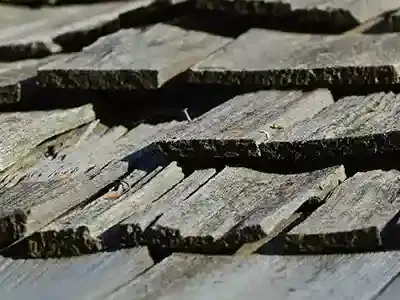
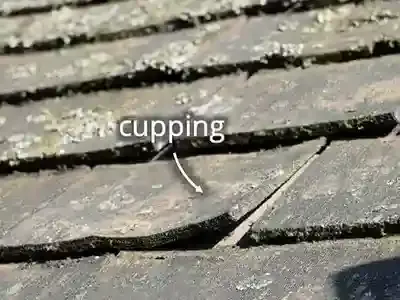
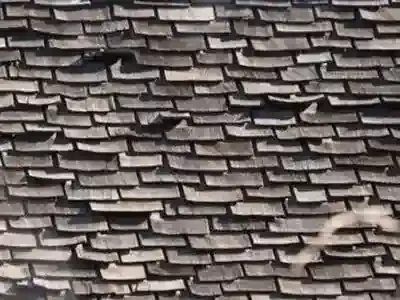
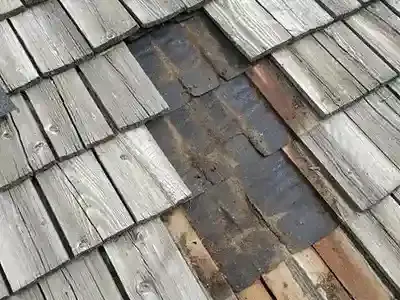
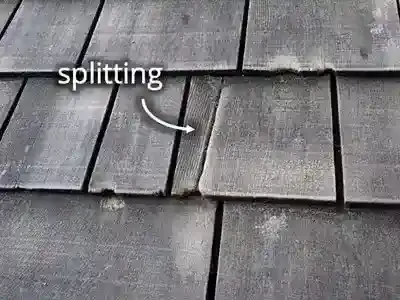
Average cost of cedar shingle maintenance and repairs
| Type of Repair | Average Cost |
|---|---|
| Minor repairs | $100-$400 |
| Moderate repairs | $365-$750 |
| Major repairs | $750-$1000 |
Clay Roof Types

How many clay roof types are there?
There are basically 4 clay terracotta roof types:

Spanish
Spanish tiles use a distinctive one-piece S-shaped design that makes installation easier. This gives them a ripple effect that prevents the staggering style of mission tiles.
Expected lifespan:
50-100 years
Average cost: $10-$20 /sq.ft.
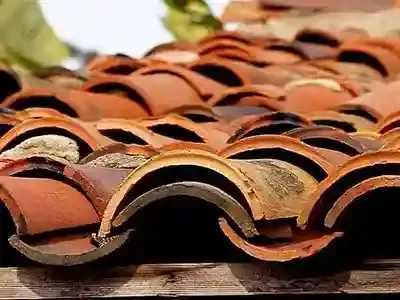
Mission
The OG barrel-style you imagine when you think of clay tile roofs. Also known as pan tiles. They interlock both up and down with curved tops that create a dramatic and rustic look.
Expected lifespan:
50-100 years
Average cost:
$8-$15 /sq.ft.
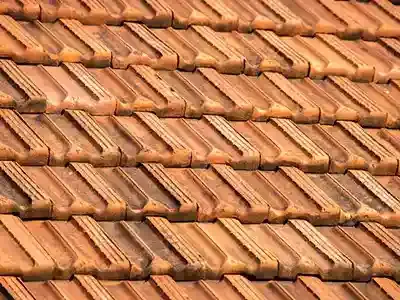
French
Flatter than barrel-style with a pair of grooves that not only improve drainage but also help give it a distinctive look, especially in the sun. These shingles also interlock.
Expected lifespan:
50-100 years
Average cost: $10-$30 /sq.ft.
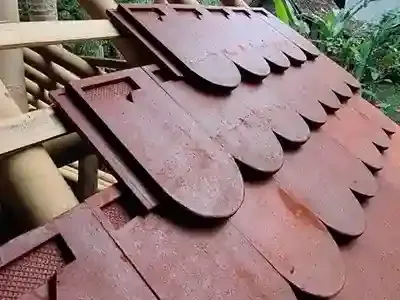
Flat
Flat design that can be interlocked like a puzzle or overlapped to create depth and dimension similar to what you see in wood shingles. Not as common but just as cool.
Expected lifespan:
50-100 years
Average cost:
$8-$15 /sq.ft.
What are clay terracotta roof tiles made from?
These tiles are made from a mixture of clay and water, shaped and then fired to create sturdy and weather-resistant shingles.
How long have clay terracotta tile roof shingles been around?
Clay terracotta has been used as a roofing material as far back as 10,000 BC. Its enduring presence is a testament to its reliability.
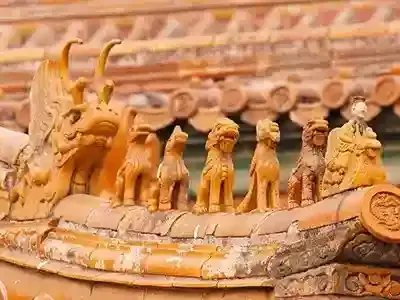
What are the advantages of a clay terracotta roof?
- Durability: They have a long lifespan and strong resilience to weather.
- Insulation: They provide excellent thermal insulation.
- Aesthetics: Clay roof tiles have a classic and distinctive appearance.
- Sustainability: The clay is made from natural materials and can be recycled.
What are some disadvantages of a clay terracotta roof?
- Cracking: Over time, tiles can develop cracks, affecting performance.
- Algae and Moss Growth: Moisture can lead to growth, impacting aesthetics and functionality.
- Poor moisture – and cold temperature – resistance: This will usually damage the underlayment and require replacement after 20 years.
- Fastener Concerns: Issues with fasteners, if ignored, can cause structural problems.
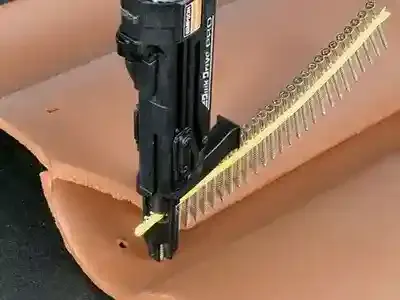
What do master home inspectors say about maintaining clay tile shingles?
Deliberate maintenance to your clay tile shingles will not only keep problems from spreading, but it will also keep maintenance costs down while keeping you dry:
- Regular Inspection: Check for cracks, loose tiles, or signs of wear.
- Cleaning: Remove debris, moss, or algae to maintain appearance and functionality.
- Resealing: Periodic resealing to enhance water resistance.
What does clay tile deterioration and damage look like?
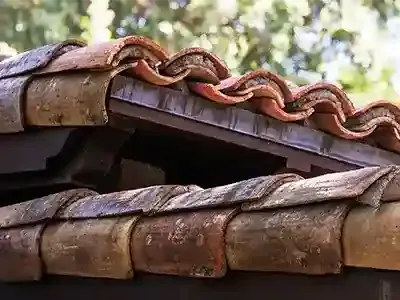
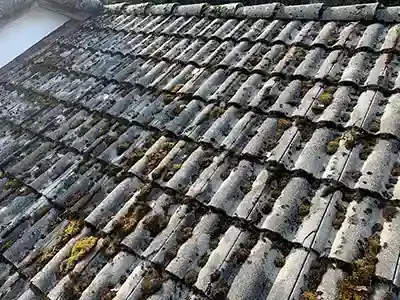
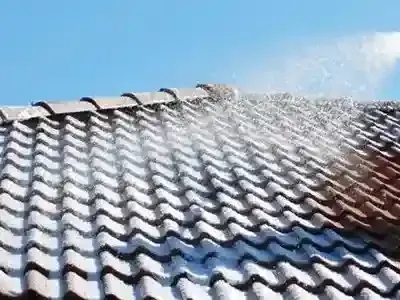

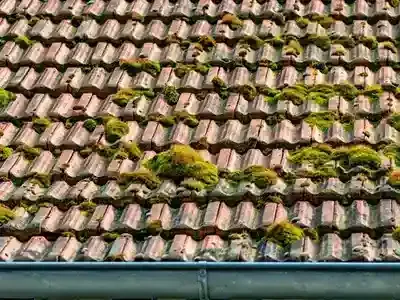
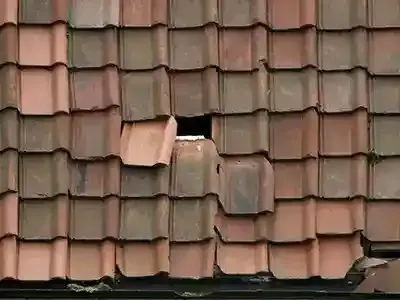
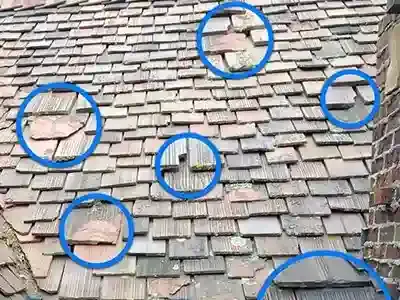
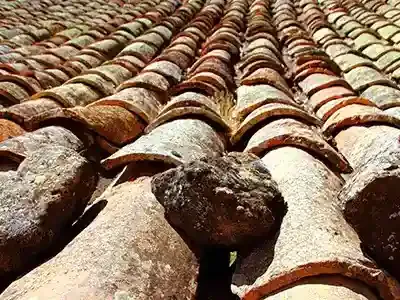
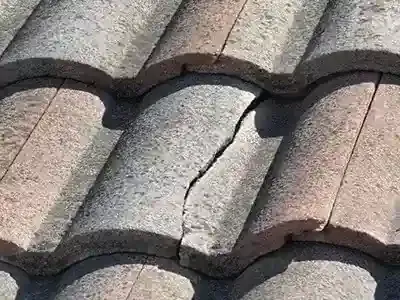
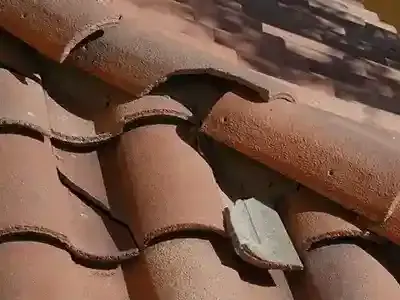
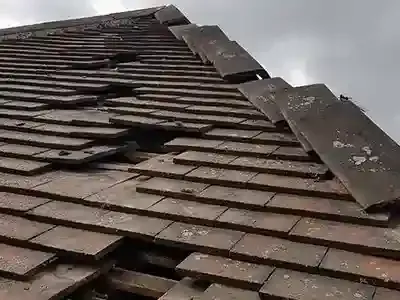
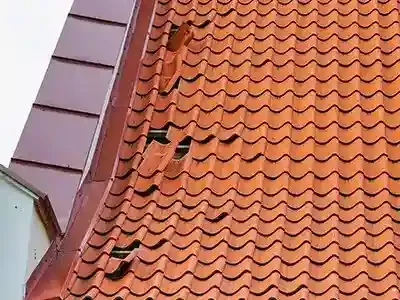
Average cost of clay tile maintenance and repairs
| Type of Repair | Average Cost |
|---|---|
| Cracks | $200-$500 |
| Weather damage | $300-$700 |
| Broken tiles | $150-$400 /tile |
Concrete Roof Types
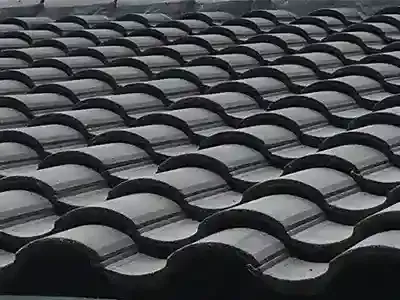
How many concrete roof types are there?
There are 4 basic different types of wood shingle:

Mission-S
These tiles feature a unique S-shaped profile. They are durable and weather-resistant, offering both functionality and curb appeal.
Expected lifespan:
30-50 years
Average cost: $4-$8 /sq.ft.
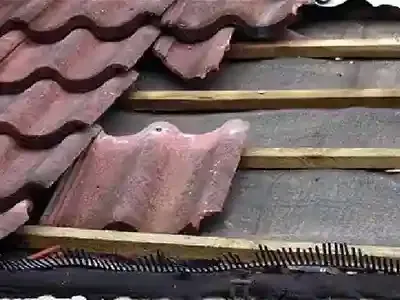
Villa
The distinctive S-shaped design to the next level by delivering better water drainage and protection against the elements.
Expected lifespan:
30 to 50 years
Average cost:
$6 to $12 /sq.ft.

Fiber-reinforced
Concrete shingles with fiberglass or cellulose fibers mixed in for extra strength and durability. Ideal for Kansas City homes.
Expected lifespan:
40-60 years
Average cost: $6-$10 /sq.ft.
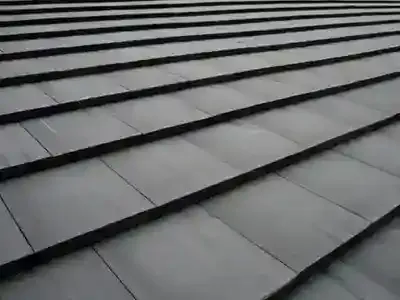
Flat
Concrete with a smooth, flat surface. A clean and modern appearance for a sleek and contemporary look.
Expected lifespan:
30 to 50 years
Average cost:
$4 to $8 /sq.ft.
What are concrete shingles made from?
Concrete shingles are typically made from a mixture of Portland cement, sand, water, and sometimes reinforcing fibers. This mixture is molded and cured to create durable shingles.
How long have concrete tile roof shingles been around?
Concrete tiles were invented in the 1840s by Adolph Kroher. He created the first machine for pressing out tiles and they soon took Bavaria by storm. In fact, several of those first roofs are still around today.
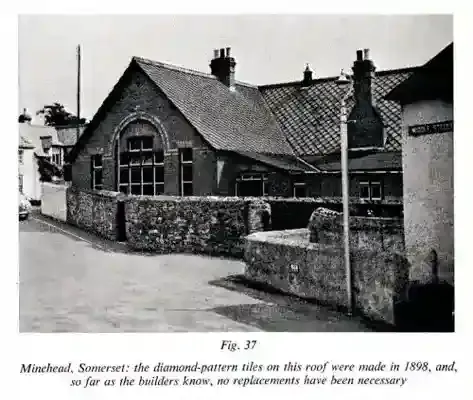
What are advantages of concrete tile shingles?
- Durability: Concrete roof shingles are known for their strength and durability, providing long-lasting protection for your home.
- Fire Resistance: Concrete is inherently fire-resistant, making these shingles an excellent choice for areas prone to wildfires or for homeowners prioritizing fire safety.
- Weather Resistance: Concrete shingles can withstand various weather conditions, including heavy rain, strong winds, and hail.
- Long Lifespan: With proper maintenance, concrete roof shingles can have a lifespan of 30 to 50 years or more.
- Versatility: Available in a variety of styles, profiles, and colors, allowing you to match different architectural aesthetics.
- Low Maintenance: Generally low maintenance aside from periodic inspections and cleaning to get the most life from your roof.
- Energy Efficiency: The thermal mass of concrete can contribute to energy efficiency by helping regulate indoor temperatures.
- Sustainability: Concrete is made from abundant and locally sourced materials, making it a relatively eco-friendly roofing option.
- Affordability: While costs can vary, concrete roof shingles are often more affordable than premium roofing materials like slate or metal.
- Noise Reduction: Concrete provides a level of sound insulation, reducing external noise from rain or other environmental factors.
- Resistance to Insects and Rot: Unlike wood, concrete is not susceptible to insect damage or rot, contributing to the shingles’ longevity.
- Warranty Options: Many manufacturers offer warranties for their concrete roof shingles, providing additional peace of mind for homeowners.
What are disadvantages of concrete tile shingles?
- Weight: Concrete is heavy, and proper structural support is crucial. Some structures may need reinforcement to accommodate the weight of concrete roofing.
- Installation Complexity: Installation may be more labor-intensive and complex compared to lighter roofing materials, potentially affecting installation costs.
- Color Fading: Over time, exposure to UV rays can lead to color fading in concrete roof shingles.
- Brittleness: While durable, concrete can be brittle. Foot traffic on the roof or heavy impact may cause chipping or cracking.
- Cost: While generally affordable, concrete shingles may have a higher upfront cost compared to some asphalt roofing options.
- Limited DIY Installation: Concrete roofing is often best installed by professionals due to its weight and installation complexities.
- Environmental Impact: The production of concrete involves significant energy consumption and emissions, contributing to its environmental footprint.
What are the 3 biggest issues with concrete tile roof shingles?
- Cracking: Over time, concrete may develop hairline cracks.
- Color Fading: Exposure to UV rays can cause fading, especially in colored concrete.
- Weight: Concrete is heavier than some other roofing materials, requiring adequate roof support.
What do master home inspectors say about maintaining concrete tile shingles?
Don’t ignore your roof. Deliberate maintenance will not only extend the life of your concrete shingles, but it will also cost you less in the long run by keeping any damage from spreading:
- Regular Inspection: Have your roof checked for cracks, damage, or loose shingles.
- Cleaning: Remove debris and moss to prevent moisture build-up.
What does concrete shingle deterioration and damage look like?
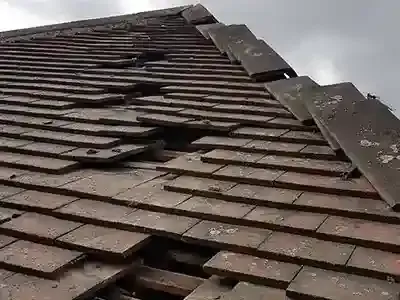



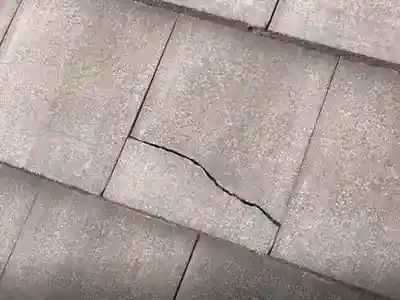

Average cost of concrete tile maintenance and repairs
| Type of Repair | Average Cost |
|---|---|
| Cracks | $200-$500 |
| Fading | $300-$700 |
| Moss and debris | $100-$300 |
Asbestos Cement Roof Types
What About Asbestos roof shingles? I almost forgot.
Let’s start with some background.
History of Asbestos
It’s believed humans have been using Asbestos since the stone age.
The Greeks wove asbestos into the wicks of their eternal flames, lamp wicks, and funeral clothes.
It was so highly regarded by the Egyptians, they used to protect a pharaoh’s corpse from decay.
And the Romans even wove asbestos fibers into their napkins and tablecloths.
It’s no wonder these convenient daily uses (lamp wicks and cooking pots) kept Asbestos so popular through the ages.
It wasn’t until the industrial revolution that Asbestos mixed into more things than you could shake a stick at.
Why use Asbestos for roof shingles?
What’s the big deal and why did people want to use it?
Let’s ignore the terminal risks for a moment and try to see it through the eyes of an 18th-century robber baron.
Why would we want to employ a material you could literally clean by cooking it?
- Excellent thermal insulation
- High tensile strength
- Highly chemical resistant
- It did not conduct electricity
- It had natural sound dampening properties
Can you imagine a better material to cover your walls, floors, ceilings, and workers while they slave away in your loud, hot, harsh, dirty, and greasy 19th-century factory? Me, either.
The Health Risk of Asbestos
Sometimes big wins come with big losses. And Asbestos has a big one.
Inhaling Asbestos fibers makes you sick. When Asbestos is disturbed, the fibers float in the air until you breathe them in. That’s when they stick to your lungs.
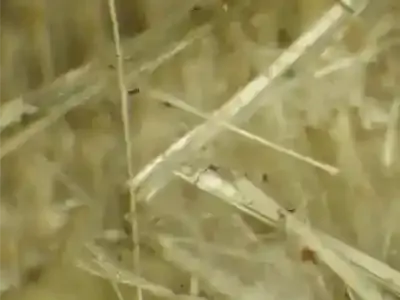
And since our bodies cannot break down asbestos fibers, they can accumulate and cause scarring and inflammation. This can take years to become something serious. The risks increase with the intensity and duration of exposure.
This latency period means individuals can go decades without symptoms.
These include:
- Asbestosis: A chronic lung condition caused by the inhalation of asbestos fibers, leading to scarring of lung tissue that makes breathing increasingly difficult.
- Mesothelioma: A rare form of cancer that primarily affects the lining of the lungs (pleura) or abdomen (peritoneum). It is closely linked to asbestos exposure and can take many years to develop after exposure.
- Lung Cancer: Greater risk is faced by individuals who are exposed to asbestos, especially if they are smokers.
- Other Pleural Disorders: Non-cancerous conditions like pleural plaques, pleural thickening, and pleural effusions can also result from asbestos exposure.
Interestingly, there are documented cases of “lung sickness” since ancient Rome. But it wasn’t until the late 19th century that medicine finally linked fibrosis to Asbestos.
By the mid-20th century, there was a well-established connection between asbestos and serious diseases like lung cancer and mesothelioma.
Asbestos Cement In Roof Shingles
Asbestos was used in roof shingles from the early 1900s to the 1980s, peaking during the 1940s-1970s.
Its durability, fire resistance, and sound dampening qualities, combined with a relatively low cost made it an ideal roofing material.
The construction industry started condemning asbestos shingles in the 70s and when the EPA finally showed up in 1989, they responded with only a partial ban on the notoriously nocuous stuff.
Health risk of Asbestos Cement Roof Shingles
It all comes down to inhaling the fibers.
The known health risks from asbestos roof shingles stem from breathing in the Asbestos fibers when the shingles are cut, disturbed, or worn out and friable.
What Do Asbestos Shingles Look Like?
Asbestos roof shingles resemble regular roof shingles aside from the fibrous look caused by the asbestos and cement.
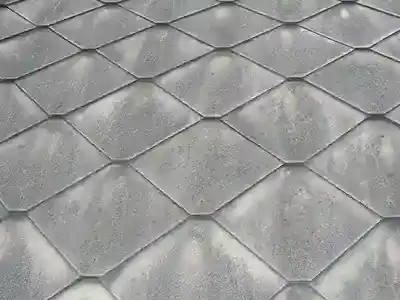
More tips from master home inspectors:
- You’ll usually find them as a muted gray or a weathered, faded white colors.
- Asbestos shingles come in various sizes and shapes but were most often found in a rectangular and diamond shapes.
- Because they were a mix of cement and asbestos, Asbestos roof shingles were also thinner than modern roof shingles.
- Despite being thinner, they’re surprisingly heavy. Heavier than asphalt shingles but lighter than cement or slate shingles.
Slate Roof Types
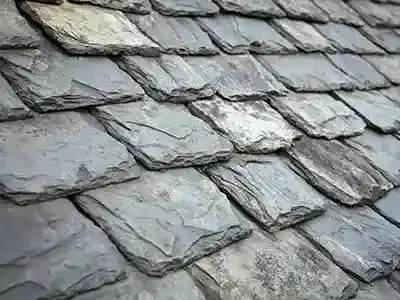
Slate roof shingles are a popular choice for homeowners due to their durability, natural beauty, and long lifespan.
If you’re considering slate roof shingles for your home, it’s essential to understand the different types, expected lifespan, maintenance requirements, advantages, disadvantages, and common issues associated with this material.
How many slate roof types are there?
There are many different types of slate roof shingles. Here are a few of the most common roof types:

Unfading
Natural stone that maintains its original color over time.
Expected lifespan:
100+ years
Average cost:
$600-$1000 /sq.

Semi-Weathering
It undergoes minimal color change.
Expected lifespan:
75-200 years
Average cost:
$500-$800 /sq.
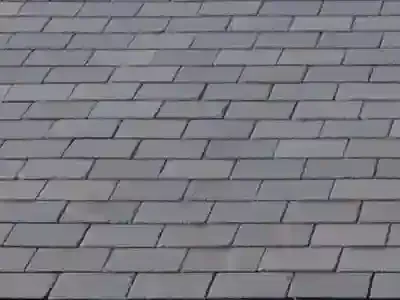
Weathering
This type develops a natural patina over time.
Expected lifespan:
50-125 years
Average cost:
$400-$700 /sq.
What are slate roof tiles made from?
Slate roof shingles are made from natural stone, specifically slate rock, which is split into thin sheets and trimmed to the required size.
How long have slate roofs been around?
Slate roofs have been around for centuries, with proof dating back to 48AD. Its longevity and natural availability made it a popular choice for roofing material.
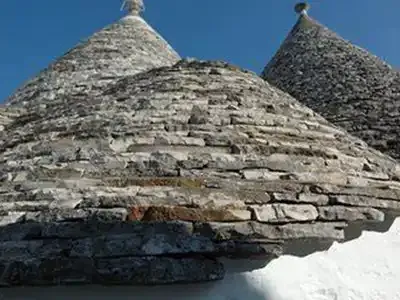
What are the advantages of a slate roof?
- Longevity and durability
- Aesthetic appeal and natural beauty
- Fire resistance
- Low maintenance
- Environmentally friendly
What are some disadvantages of a slate roof?
- High initial cost – Skilled labor is needed
- Heavy weight – requires a sturdy roof structure
- Variations – natural slate has limited color options
- Brittle – Hard but easy to break
What do master home inspectors say about maintaining slate tiles?
Ongoing maintenance won’t just help your slate tiles last for lifetimes, but will also keep maintenance and repair costs down along the way:
- Regular inspections for cracked, damaged, or loose shingles
- Clearing debris and keeping gutters clean
- Cleaning to prevent moss and algae growth.
- Replacement of damaged or missing shingles
What are the biggest issues with slate roof shingles?
- Cost-prohibitive for some homeowners
- Installation and repair require skilled professionals
- Weight can be a concern for older or weaker roof structures
- Installation Errors– Improper installation can lead to issues
- Color Fading – Exposure to sunlight may affect color
- Damage – Natural slate can crack and break over time
What are the 5 most common types of damage to slate roof types?
- Cracks and fractures – Especially in natural slate
- Delamination of layers – In areas with extreme hot and cold temperatures
- Weathering and erosion – Requires regular repair and maintenance
- Loose or Missing Tiles – Improper installation or weather-related
- Moss and Algae – Requires regular cleaning
What does slate shingle damage and deterioration look like?

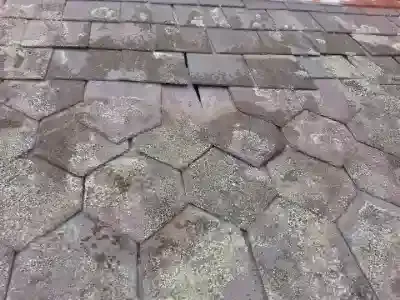
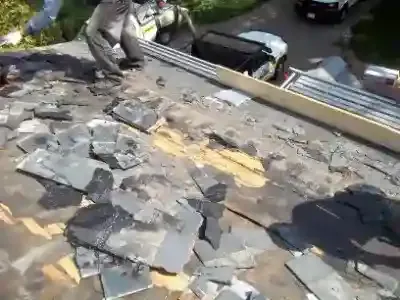
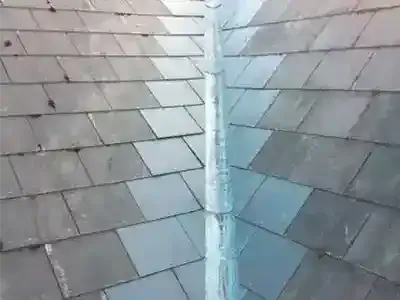
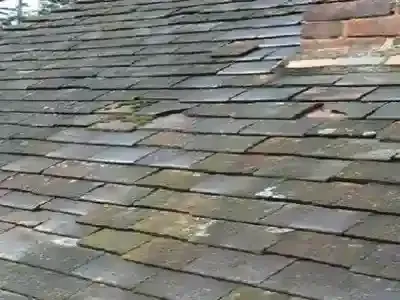
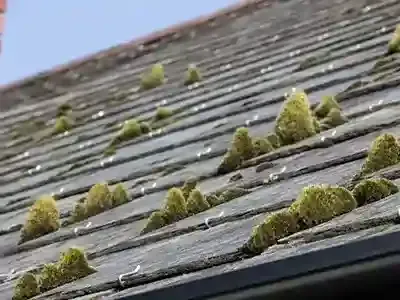
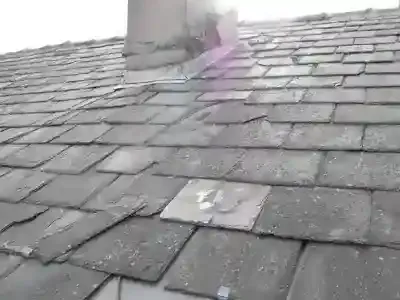
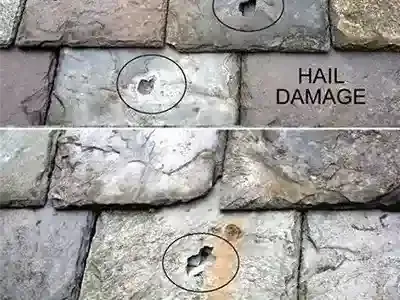
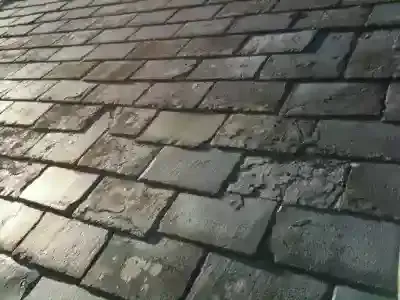
Average cost of slate roof maintenance and repairs
| Type of Repair | Average Cost |
|---|---|
| Cracks and fractures | $150-$600 |
| Delamination | $400-$800 |
| Weathering and erosion | $500-$1000 |
| Missing shingles | $200-$400 |
| Moss/Algae Cleaning | $200-$500 |
Metal Roof Types

How many metal roof types are there?
There are 3 basic different types of metal roofs:
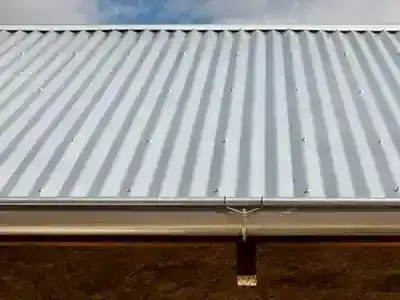
Corrugated
Sheets of metal with wavy patterns, commonly used for agricultural and industrial buildings.
Expected lifespan:
25-60 years
Average cost:
5-10 /sq.ft.
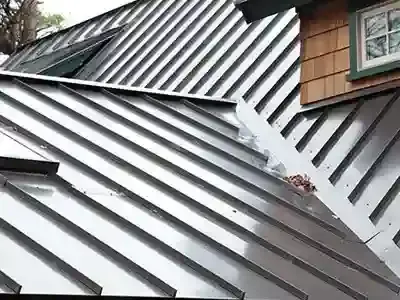
Standing seam
Vertical panels with hidden fasteners joined by raised seams, providing a sleek, modern look.
Expected lifespan:
30 to 50 years
Average cost:
$10 to $20 /sq.ft.
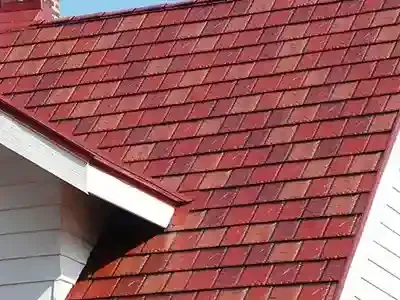
Metal shingle
Individual overlapping shingles meant to resemble materials like slate or wood shake.
Expected lifespan:
30-50 years
Average cost:
$10-$15 /sq.ft.
What are metal roofs made from?
Because of their durability and resistance to corrosion, metal roofs are typically made from steel, aluminum, zinc, or copper.
How long have metal roofs been around?
Metal has been used for roofing since the 1700s, with copper and lead being among the earliest materials. Modern metal roofing gained popularity in the 19th century.
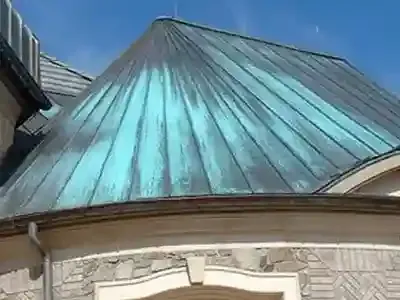
What are advantages of choosing a metal roof?
- Longevity – Metal roofs have a longer lifespan compared to traditional roofing materials. Their resistance to weather-related damage and corrosion contributes to a roof that can last for several decades, providing long-term value for homeowners.
- Durability – Metal roofs are known for their exceptional durability. They can withstand harsh weather conditions, such as heavy rain, snow, and hail. This durability contributes to a longer lifespan compared to traditional roofing materials.
- Energy efficiency – Metal roofs reflect the sun’s rays, preventing excessive heat absorption. This reflective property helps keep the interior of the home cooler, leading to potential energy savings. This is particularly beneficial in warmer climates.
- Environmentally Friendly – Many metal roofing materials are recyclable, making them an environmentally friendly choice. This recyclability reduces the environmental impact associated with roofing materials, appealing to homeowners who prioritize sustainability.
- Low maintenance – Metal roofs require minimal maintenance. They are less susceptible to issues like rotting, warping, and insect damage that can affect other roofing materials. This low-maintenance aspect saves homeowners time and money over the life of the roof.
- Fire resistance – Metal roofs are non-combustible and provide excellent fire resistance. This quality can be crucial in areas prone to wildfires, offering an added layer of protection for homes.
- Weight – Metal roofs are lighter than some other roofing materials, reducing the overall load on the structure of the house. This can be advantageous in terms of structural integrity and may be particularly relevant for certain types of buildings.
- It looks cool – Metal roofs come in a variety of styles, colors, and finishes, allowing homeowners to choose a look that complements their home’s design. This aesthetic versatility provides an opportunity for personalization.
These factors make metal roofs a practical and attractive option for homeowners, including those in the Kansas City area.
What are disadvantages of having a metal roof?
Metal roofing, while offering several benefits, does have certain disadvantages:
- Cost: Initial installation of a metal roof is typically more expensive than other roofing materials.
- Noise: Metal roofs can be noisier than other types of roofs during rain or hail unless additional insulation is used.
- Denting: Hail and falling objects can dent some types of metal roofing materials.
- Expansion and Contraction: Metal roofs can expand and contract with temperature changes, which may require additional fasteners or expansion joints to prevent damage.
- Inconsistency in Color Match: If a repair is needed or an addition is put on the house, it may be difficult to match the color of the existing metal.
- Accessibility: In wet or icy conditions, a metal roof can be slippery and dangerous to walk on.
- Expertise to Install: Proper installation requires experienced contractors who are familiar with working with metal roofing, which might not be as readily available as those for traditional materials.
What are the 3 biggest issues with metal roofs?
- Cost: Metal roofing is typically more expensive to install than traditional asphalt shingles. The initial investment is higher, although it may be offset over time due to the longevity and durability of metal roofs.
- Corrosion: Although modern metal roofs are typically treated with protective coatings, they can still be vulnerable to corrosion over time, especially if installed in areas with high moisture, salty air (coastal regions), or acidic rain. This makes the choice of material (e.g., galvanized steel, aluminum, copper) and regular maintenance important items to consider.
- Noise: Metal roofs can be noisier than other types, especially during rain or hail. Insulation and solid decking can reduce noise, but may not fully conceal the issue. This could be a major downside if you need it quiet.
What do master home inspectors say about maintaining metal roofs?
Metal roofs need maintenance if you want to keep them healthy so you can stay dry. This is the kind of maintenance you can expect to do:
- Regular Inspections: What can I say…we love inspecting things. Inspect your metal roof every year for signs of damage, aging, corrosion, loose fasteners, or corroded sealant. This can keep minor issues from becoming major problems.
- Keep It Clean: Keep your metal roof clean and clear from dirt, debris, leaves, branches, and grime. This will stop moisture retention and corrosion, especially in areas with acid rain or sea spray.
- Re-Coat: Depending on the type of metal and the environment, a metal roof may need periodic re-coating to protect against UV rays, corrosion, and to maintain its aesthetic appeal.
- Keep Fasteners Sealed: Sealants used around penetrations such as vents, skylights, and chimneys should be checked and possibly re-applied if they are deteriorating. Fasteners and clips that may have become loose due to thermal expansion and contraction should be tightened or replaced.
- Gutters and Downspouts: Keep gutters and downspouts clear to preventing water from collecting around the roof edges, which causes damage over time.
- Scratches and Dents: Don’t scratch or dent your metal roof during maintenance. If ignored, this can compromise the protective coatings and cause rust.
Being prepared to provide ongoing and consistent maintenance means you’ll enjoy years of hassle-free and no-surprise life from your own metal roof.
What does deterioration and damage on metal roofs look like?
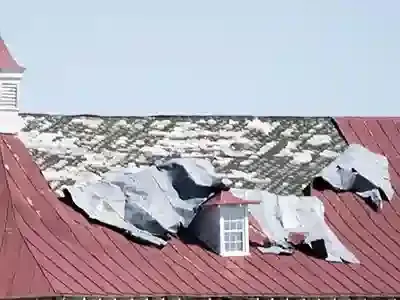
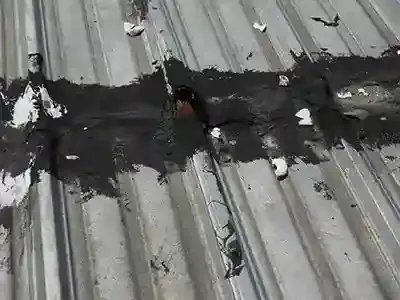
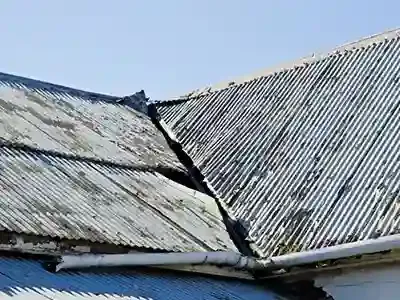

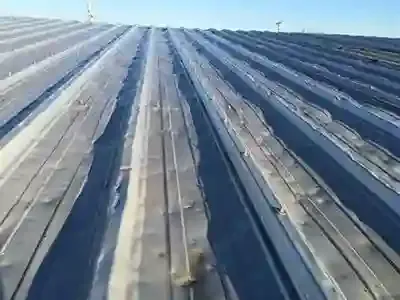
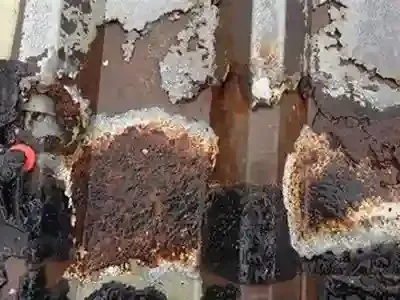
Average cost of metal roof maintenance and repairs
| Type of Repair | Average Cost |
|---|---|
| Corrosion | $200-$500 |
| Dents and punctures | $150-$400 |
| Attaching loose panels | $300-$700 |
Flat Roof Types
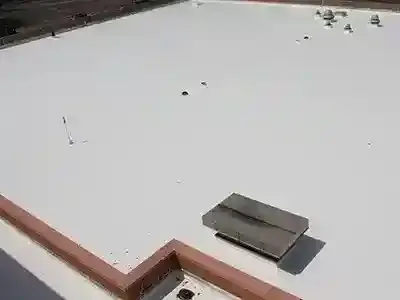
How many flat roof types are there?
A flat roof isn’t actually flat. It has a slight angle toward the drain.
But since it holds snow and water alot longer than pitched roof types, it takes a different material to keep it watertight.
There are basically 4 different types of flat roofs:
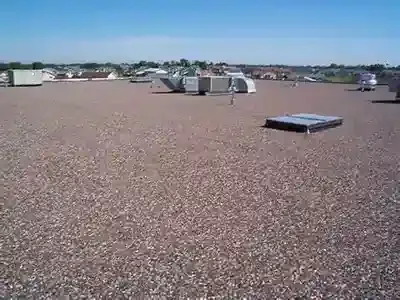
Built-Up Roof (BUR)
Layers of bitumen (asphalt or coal tar) and reinforcing fabrics are built up to form a waterproof finish topped with gravel.
Expected lifespan:
15-30 years
Average cost:
$4-$6 /sq.ft.
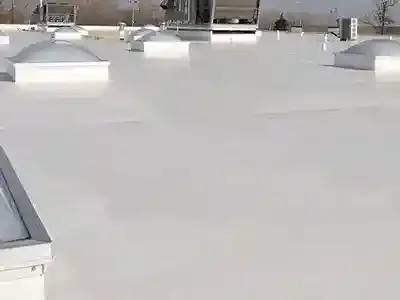
Single-Ply Membrane
Materials such as TPO, PVC, or EPDM are used in large rolls that overlap or seam to create a continuous waterproof barrier.
Expected lifespan:
15-20 years
Average cost:
$3.50-$7.50 /sq.ft.
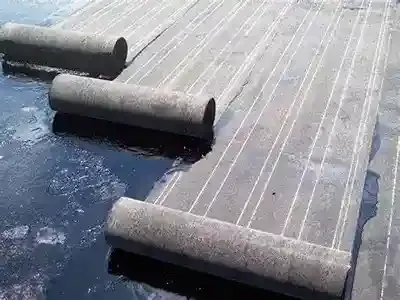
Modified Bitumen
Asphalt that has been modified with polymers or solvents and applied in rolls that are usually heat-fused on the roof.
Expected lifespan:
10-20 years
Average cost:
$3-$6 /sq.ft.

Spray Poly Foam (SPF)
Applied to existing roofs. Goes on as a liquid then expands into foam to create a solid layer across the surface.
Expected lifespan:
20-40 years
Average cost:
$3-$6 /sq.ft.
What are flat roofs made from?
Built-Up Roofing – Alternating layers of bitumen and reinforcing fabric topped with stone or gravel.
Single-Ply Membrane – TPO is made of thermoplastic olefin, PVC is polyvinyl chloride, and EPDM is synthetic rubber.
Modified Bitumen – Asphalt modified with polymers, plus a polyester or fiberglass mat for reinforcement.
Spray Polyurethane Foam (SPF) – Closed-cell polyurethane foam material.
How long have flat roofs been around?
Flat roofs have been used for over 100 years in the U.S.
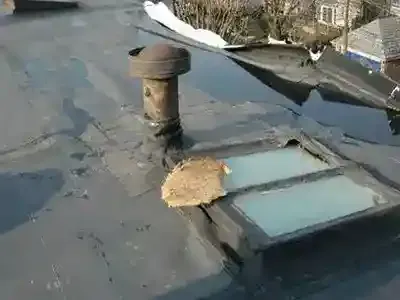
What are the advantages of a flat roof?
Flat roofs offer several advantages:
- Space Utilization: The flat surface can be used for various purposes, including a place for HVAC units, green roofing, solar panels, or even a rooftop garden or patio.
- Cost-Effective: They are generally less expensive to install than pitched roofs due to less surface area and reduced material costs.
- Accessibility: Flat roofs are easier to access for maintenance, repairs, and cleaning compared to sloped roofs.
- Simple Design: Architecturally, flat roofs provide a modern, minimalist look and are easier to design and construct for large commercial buildings.
- Energy Efficiency: Many flat roof materials reflect sunlight, which can help reduce cooling costs in hot climates.
- Flexibility of Interior Space: Without sloping walls, building interiors can have more usable space, making them ideal for warehouses, large retail spaces, and other commercial buildings.
What are some disadvantages of a flat roof?
The disadvantages of flat roofs include:
- Drainage Issues: Flat roofs do not drain as efficiently as pitched roofs, leading to water pooling and potential leakage if not properly designed with adequate drainage.
- Limited Lifespan: Many flat roofing materials have shorter lifespans than pitched roof materials, requiring more frequent replacement or repair.
- Maintenance Requirements: To avoid problems, flat roofs often require more regular maintenance and inspection than pitched roofs.
- Susceptibility to Leaks: Due to water pooling and potential damage from foot traffic or debris, flat roofs can be more prone to leaks.
- Structural Considerations: Flat roofs may require additional structural support to handle the weight of water or snow that may accumulate on the surface.
- Not Ideal for All Climates: In areas with heavy snowfall or frequent, intense rain, flat roofs may not be as effective or durable as sloped roofs.
- Limited Material Options: The materials suitable for flat roofs, like EPDM, TPO, and bitumen, may not offer the same aesthetic diversity as sloped roof materials like shingles or tiles.
What do master home inspectors say about flat roof maintenance?
Maintaining a flat roof involves several key practices:
- Check It Regularly: Conduct biannual inspections and additional checks after severe weather conditions. Look for signs of damage, such as cracks, blisters, or tears.
- Keep Roof Clean: Keep the roof free of debris like leaves, branches, and dirt that can cause blockages or retain moisture.
- Keep Drains Clear: Ensure that gutters, downspouts, scuppers, and internal drainage systems are clean and clear to prevent water accumulation.
- Damage Repair: Any identified damage such as leaks, punctures, or worn areas should be repaired quickly to avoid further degradation.
- Surface Cleaning: Clean the roof surface to prevent the growth of algae, moss, or fungi, which can degrade roofing materials over time.
- Checking Flashings: Ensure that the flashings (the materials used to waterproof areas where the roof meets vertical surfaces like walls or chimneys) are intact and properly sealed.
- Recoat and Re-seal: Depending on the material, a roof may need to be recoated or resealed periodically to ensure it remains weatherproof.
- Ponding Water: After a rainstorm, check for areas of standing water. Ponding can lead to material degradation and leaks.
- Watch the Weight: Be cautious of placing excessive weight on the roof, as it may compromise the roof’s structural integrity.
- Maintain Rooftop Equipment: If the flat roof supports equipment like HVAC units, ensure these are well-maintained and aren’t causing damage to the roof.
Proactive and regular maintenance is key to extending the life of a flat roof and preventing costly repairs.
What are the 3 biggest issues with flat roof types?
- Leakage: Can occur from poor installation, lack of maintenance, or damage.
- Pooling Water: Improper drainage can lead to water accumulation, eventually degrading the roofing material and causing leaks.
- Thermal Movement: Expansion and contraction of the roofing material can lead to splits, cracks, and weakened seams.
What are the most common types of damage to flat roof types?
Here’s a rough idea of the types of damage you can expect:
- Patching Leaks or Small Areas of Damage: minor repairs, like sealing a small leak.
- Recovering or Re-coating a Flat Roof: Applying a new coating for enhanced waterproofing or UV protection.
- Replacing Flashing: The cost to replace flashing can vary.
- Drainage System Repairs: Repairing gutters or internal drains.
- Fixing Ponding Issues: This can involve creating new slopes or adding additional drains.
- Extensive Repairs for Significant Damage: For large areas needing extensive repair or partial replacement.
- Replacing the Entire Roofing System: Complete replacement for a small residential flat roof.
Please note these are ballpark figures as of the last available information. Actual costs can differ, and it is important to get multiple quotes for any job. It’s also advisable to have repairs done by qualified professionals to ensure quality work and to prevent further issues.
What does flat roof damage and deterioration look like?
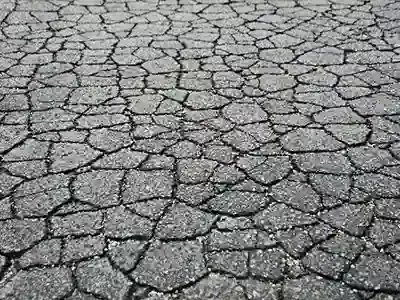


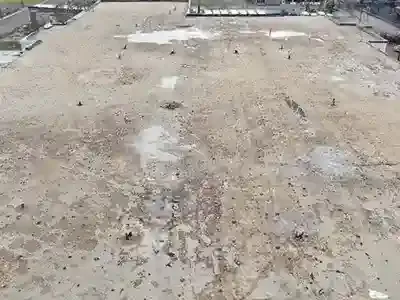
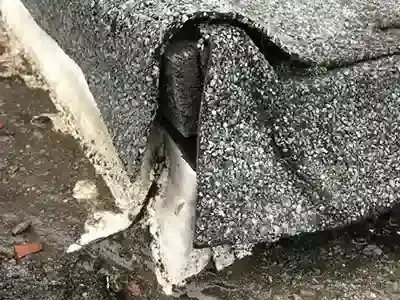
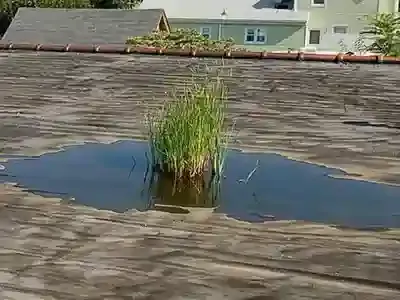
Average cost of flat roof maintenance and repairs
| Type of Repair | Average Cost |
|---|---|
| Leaks and minor damage | $300-$500 |
| Extensive repairs and major damage | $4,000-$7,000 |
| Re-coating | $1.50-$3.00 |
| Flashing | $200-$500 |
| Drainage | $300-$3000 |
| Ponding | $200-$500 |
| Replace roof | $8,000-$15,000 |














